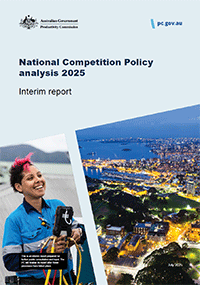National Competition Policy analysis 2025

Interim report
Released 07 / 08 / 2025
The interim report supports the National Competition Policy process by analysing the economic effects of two policy reforms – occupational licensing reform to promote labour mobility and adopting international and overseas standards. These two reforms would promote competition and increase Australia’s GDP.
- Regulated standards and occupational licensing are two different ways that governments promote important public policy goals. But these regulations can also restrict trade, impose costs and impact competition.
- The reforms the Productivity Commission (PC) has been asked to model have the potential to raise GDP by up to 0.24%.
- Aligning standards across Australia, and with international and overseas standards could be worth around $1.9 billion to $3.8 billion per year (0.1% to 0.2% of GDP).
- Providing labour mobility for high‑risk licensed occupations across Australia could be worth up to $846 million per year (0.04% of GDP).
- Part of this benefit would be to the electrical trades, which we estimate to have an upper bound benefit of $51 million to $62 million per year.
- Of the 7,519 current Australian Standards, 893 are referenced in legislation and of these only 21 (2%) are not aligned with an existing international standard.
- 76% of these mandated standards are bespoke Australian Standards without any equivalent international standard – 90% of these standards relate to three industries only.
- Only 26% of these mandated standards are consistently implemented by the states, territories and Commonwealth.
- Around 40% of all Australian Standards referenced in legislation are superseded, obsolete or withdrawn.
- Occupational licensing reform could promote labour mobility and improve productivity, as workers move to places where their skills are most needed and valued. Much has been gained through previous reform efforts, which created national licensing for health professions and automatic mutual recognition for many other occupations.
- Not all states have joined the automatic mutual recognition scheme (Queensland does not participate), and states and territories continue to exclude some professions.
- Other reforms to promote competition were canvassed in the 2024 National Competition Policy Study and remain potentially important for further consideration.
- High value reforms included: occupational licensing reforms to lower restrictions (being considered in the PC’s current Building a Skilled and Adaptable Workforce inquiry); public procurement reform; data sharing; and road user charging.
- Preliminaries: Cover, Copyright and publication detail, Opportunity for comment, Request for advice, Contents, Acknowledgements and Disclosure of interests
- Key points
- About this study
- Headline results
- Standards
- Occupational licensing
- Additional NCP reforms
- Appendices
- A. Public consultation
- B. Standards
- Key points
- B.1 What are standards?
- B.2 Australian policy is to align with international standards where possible
- B.3 Do regulated standards align with international or overseas standards?
- B.4 The potential net benefits of greater harmonisation
- B.5 Priority areas for review
- B.6 Other reforms to standards
- Attachment B.1 – Impact analysis guidance
- Attachment B.2 – WTO notification
- Attachment B.3 – Commonwealth impact analyses
- C. Occupational licensing
- Key points
- C.1 About occupational licensing
- C.2 What are the different approaches to licence interoperability?
- C.3 Are current arrangements affecting labour mobility?
- C.4 Quantitative impacts
- C.5 The way forward
- Abbreviations
- References
Printed copies of this report can be purchased from Canprint Communications.
You were invited to make written submissions by 5 September 2025.


